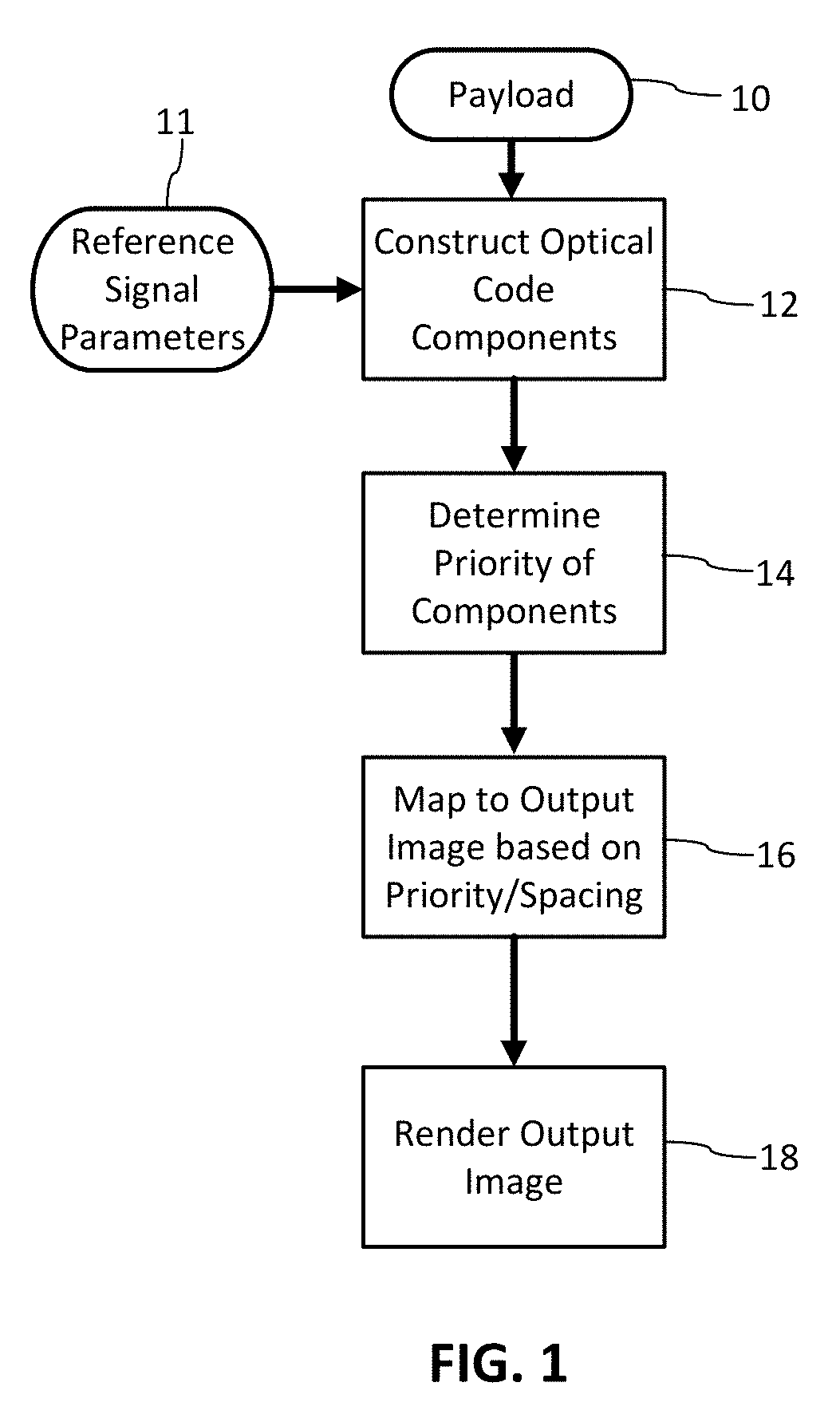Generating and reading optical codes with variable density to adapt for visual quality and reliability
- Summary
- Abstract
- Description
- Claims
- Application Information
AI Technical Summary
Benefits of technology
Problems solved by technology
Method used
Image
Examples
embodiment 420
[0248]As in the arrangement of FIG. 5, two signal components—payload and reference—are first determined. One is used to modulate the other. However, rather than modulate phases of reference signal components (or on / off-keying of such components), embodiment 420 identifies positions of local extrema in the spatial domain reference signal, and forms marks (dots) in an output signal block at such positions—depending on a value of a spatially-corresponding element of the payload signal.
[0249]FIG. 43 illustrates an excerpt 431 of an encoded payload component block 432 (which may also be termed a message data array). This part is comprised of an array of signal elements, each drawn from a set of two possible values (e.g., {0,1}, {−1,1} or {black,white}). The depicted excerpt spans an area of just 5×5 elements, but the full payload component block is typically much larger, e.g., having 16, 32, 64 128 or 256 elements (e.g., pixels) on a side. The payload component block is commonly square, ...
first embodiment
[0368]In the second particular embodiment, each respective bit position in the message string is associated with a single extrema location in the reference signal (not a pair of locations, as in the first embodiment). Each successive bit of the message signal can be mapped to a successive location in the Table 2 ranking, i.e., the first message bit corresponds to the darkest extrema (rank #1); the second message bit corresponds to the second-darkest extrema (rank #2), etc.
[0369]In this second embodiment, a message bit of “1” is signaled by a mark, but a message bit of “0” is signaled by absence of a mark. (Or vice versa.) Instead of drawing from 2048 candidate locations and marking only half, this second embodiment draws from 1024 locations. Some of these 1024 locations are marked and some are not—depending on whether a “1” or “0” bit is being represented at that location.
[0370]This second arrangement is illustrated in FIGS. 65A and 65B. In comparison with FIGS. 64A and 64B, it will...
third embodiment
[0383]In particular, the marks in this third embodiment are 2×1, or 1×2, element features, termed “dyads.” Each dyad comprises a marked element adjacent an unmarked element.
[0384]Four possible dyads are shown in FIGS. 66A-66D. FIGS. 66A and 66B show horizontal dyads. FIGS. 66C and 66D show vertical dyads. FIG. 66A represents a “0” message bit. FIG. 66B represents a “1” bit. FIG. 66C represents a “0” bit. FIG. 66D represents a “1” bit. Each is comprised of a dark (marked) element adjacent to a white (unmarked) element.
[0385]In this third embodiment, instead of ranking candidate single elements in the reference signal tile by value (e.g., as in Table 2), 2×1 and 1×2 areas across the tile are ranked by their average (or total) value. The darkest 1024 areas are selected. Each is associated with one bit position in the 1024 bit message. Each area is marked with a dyad. If a selected area is horizontally-oriented, one of the two horizontal dyads, FIG. 66A or 66B, is used—depending on whet...
PUM
 Login to View More
Login to View More Abstract
Description
Claims
Application Information
 Login to View More
Login to View More - R&D
- Intellectual Property
- Life Sciences
- Materials
- Tech Scout
- Unparalleled Data Quality
- Higher Quality Content
- 60% Fewer Hallucinations
Browse by: Latest US Patents, China's latest patents, Technical Efficacy Thesaurus, Application Domain, Technology Topic, Popular Technical Reports.
© 2025 PatSnap. All rights reserved.Legal|Privacy policy|Modern Slavery Act Transparency Statement|Sitemap|About US| Contact US: help@patsnap.com



